Bibliography Background About KRIS
Hypothesis #6: Predation by introduced fish species is limiting Atlantic salmon production in the Sheepscot River and its tributaries.
Literature Foundation
The Fish Populations in Gulf of Maine Rivers and Lakes Background page provides wider information on the Sheepscot River and both its native and introduced fish species. There are many native fish species that predate upon or compete with Atlantic salmon including "eels, northern pike, brook trout, larger salmon, and other predaceous fishes" (Danie et al., 1984). Co-evolution would ingrain behavior in juvenile Atlantic salmon to avoid predation and to lessen competition with brook trout, yellow perch, and other native fish by niche partitioning. Interactions with introduced species may be a greater problem particularly since there have been changes in habitat conditions that often favor these non-natives (MASC, 1997). The National Academy of Sciences (2003) noted that "salmon evolved in environments that had predators and competitors but not the introduced species and not under today's conditions, when salmon populations are seriously depleted."
The Maine Atlantic Salmon Commission (MASC, 1997) expressed concern about predation on Atlantic salmon by introduced sport fish like brown trout and Splake (brook/lake trout hybrid) and called for competition studies to evaluate the risk of continued stocking. The same report also documents illegal introductions of large mouth and small mouth bass into lakes in all Maine Distinct Population Segment (DPS) Atlantic salmon rivers. MASC (1997) found the greatest threat to salmon smolts was likely from chain pickerel and smallmouth bass:
"Chain pickerel and smallmouth bass occur in many sections of the seven rivers. While habitat differences between these warmwater species and salmon parr minimizes pickerel predation on age-0+ and age-1+ parr in nursery habitat, researchers have documented predation on migrating smolts (Barr 1962, Van den Ende 1993). Atlantic salmon smolts were the most important dietary item of chain pickerel (11.5 - 24 inches in length) during the smolt run period on the Penobscot River, where 58 percent of all pickerel stomachs contained food items and smolts represented 80 percent of the wet weight of all prey items (Van den Ende 1993)."
The Maine Department of Inland Fisheries and Wildlife (Boucher, 2005) describe threats to Maine's lakes posed by introduced species:
- "Since 1986, Maine fishery biologists have determined that illegal introductions have established new large mouth bass populations in 57 additional lakes...
- Largemouth bass are being illegally introduced into many Downeast waters at an alarming rate with unpredictable consequences.....
- Unauthorized introductions of invasive, exotic fish species ....... may cause irreversible changes to entire aquatic ecosystems by restructuring plankton and forage fish communities that have evolved since the last glacial retreat.....
- Strategies to eliminate or control invasive fish are difficult to design and implement, costly, and almost entirely ineffective."
The NAS (2003) found that dams not only changed predator-prey dynamics affecting Atlantic salmon, but that they were also linked in some cases to changes in water quality. McCullough (1999) notes that increased water temperatures may cause ecological shifts, where salmonids become less able to compete with warm water species and may become more subject to predation.
Sheepscot Literature and Data
Bryant and Mahoney (1950) documented chain pickerel as occurring in ponds throughout the Sheepscot basin and in the West Branch Sheepscot River. Meister (1982) made many observations about introduced species, predation and Atlantic salmon:
- Brown trout..... now thrive in the stream above and below Sheepscot Pond. Their presence throughout a large segment of the river above Coopers Mills seriously limits salmon production in this section of the river.
- Landlocked salmon, native to the State of Maine, has been stocked in Sheepscot Pond.
- Lake trout (togue) introductions have been made in Sheepscot Pond.
- Chain pickerel also thrive in several of the coldwater ponds of the Sheepscot drainage and in the deadwater areas of the streams. In these waters they may compete with the more desirable coldwater species.
- Predation by pickerel is a serious factor in the management of our landlocked and Atlantic salmon resources
- Largemouth bass in Sherman Pond were planted by fishery scientists but other introductions were made ..... by unauthorized individuals and/or organizations.
- Smallmouth bass adapt readily to cool rocky-bottomed streams, and many sections of the Sheepscot River provide bass habitat. While smallmouths are presently limited to the waters of the main river, they will eventually become established in the waters of the West Branch...... It seems likely that some reduction in the production of salmon can be expected as bass become more widespread.
- Smallmouth bass have been long-time residents of several ponds near the headwaters of the Dyer River.
The smallmouth and largemouth bass were introduced in the 1940's and 1950's (Meister, 1982). Unlike the bass and brown trout, landlocked Atlantic salmon and lake trout stocked in Sheepscot Pond have not been able to establish reproducing populations; and anadromous Atlantic salmon are not known to spawn above Sheepscot Pond. Therefore, it is unlikely that these species negatively impacted native sea-run salmon.
Foye (1967) acknowledged that impoundments in the Sheepscot had converted it to a watershed favoring warm water species:
"The Sheepscot drainage contains a preponderance of warmwater lakes and ponds, and, on an acreage basis, warmwater fish habitat is more than double that of the coldwater habitat. In addition, four of the five coldwater ponds contain one or more species of warmwater game fish, which compete with and prevent maximum yields of the coldwater species. Spawning and nursery facilities for resident coldwater species are not adequate in some waters to maintain fishable populations..."
The Sheepscot River is widely recognized as having a problem with high water temperatures (see Hypothesis #2), which is expected to put Atlantic salmon at a competitive disadvantage with warm water species (Arter, 2004; KSWCD, 2003).
Basinwide Summaries
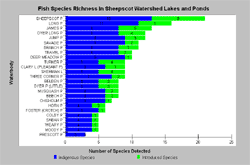 This chart shows the number of fish species (richness) of each of the lakes or ponds in the Sheepscot River watershed, including the number of native (blue) and introduced (green) species. Sheepscot Pond has the greatest species diversity, but also eight species that are nonnative. In general, the larger ponds are likely to be warm water habitat during summer, but small ponds nearer headwaters remain more favorable to cold water, native species. Of all the ponds and lakes surveyed, only Prescott Pond had no non-native fish species. Sampling was not exhaustive and the spread of introduced fish can be rapid; consequently, these data should be viewed as conservative in their estimate of introduced species. Data are from the Maine Department of Inland Fisheries and Wildlife.
This chart shows the number of fish species (richness) of each of the lakes or ponds in the Sheepscot River watershed, including the number of native (blue) and introduced (green) species. Sheepscot Pond has the greatest species diversity, but also eight species that are nonnative. In general, the larger ponds are likely to be warm water habitat during summer, but small ponds nearer headwaters remain more favorable to cold water, native species. Of all the ponds and lakes surveyed, only Prescott Pond had no non-native fish species. Sampling was not exhaustive and the spread of introduced fish can be rapid; consequently, these data should be viewed as conservative in their estimate of introduced species. Data are from the Maine Department of Inland Fisheries and Wildlife.
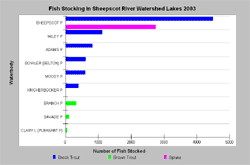 The Maine Department of Inland Fisheries and Wildlife manages Sheepscot basin lakes and ponds for recreational fisheries. Their stocking records for 2003 are shown in the adjacent chart. Brook trout, which are native to the Sheepscot, are the predominant species planted. Sheepscot Pond was planted with 4500 brook trout, and lesser numbers in were planted in five other ponds. A total of 2,750 brook and lake trout hybrids, known as Splake, were stocked in Sheepscot Pond in 2003 as well. Brown trout plants were smaller with Branch, Savade and Clary Ponds receiving 330, 100 and 25, respectively.
The Maine Department of Inland Fisheries and Wildlife manages Sheepscot basin lakes and ponds for recreational fisheries. Their stocking records for 2003 are shown in the adjacent chart. Brook trout, which are native to the Sheepscot, are the predominant species planted. Sheepscot Pond was planted with 4500 brook trout, and lesser numbers in were planted in five other ponds. A total of 2,750 brook and lake trout hybrids, known as Splake, were stocked in Sheepscot Pond in 2003 as well. Brown trout plants were smaller with Branch, Savade and Clary Ponds receiving 330, 100 and 25, respectively.
Splake tend not to migrate downstream out of lakes. There is no natural production in the Sheepscot basin and Atlantic salmon are not known to run upstream of Sheepscot Pond, where they are stocked. Therefore, it is unlikely that Splake and salmon have negative competition or predatory interactions. Brown trout planted in Branch Pond and Savade Pond may well distribute downstream in the West Branch and lower mainstem, where there is the potential for competition with or predation on juvenile Atlantic salmon.
West Branch Sheepscot River Fish Community Including Predatory Species
The six charts below show data from the Maine Atlantic Salmon Commission (ASC). ASC surveyors typically recorded exact counts of Atlantic salmon, but for other species only relative abundances were recorded. A relative abundance of 1 means the number of individuals was not recorded, 2 means 1 to 5 individuals, 3 means 5 - 10 individuals, and 4 means greater than 10 individuals.
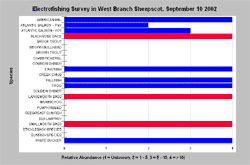 The fish community structure in the lower West Branch Sheepscot near its mouth (RKM 0.54) in September 2002 included Atlantic salmon and three nonnative species, including two predatory ones, the largemouth and smallmouth bass. Research on the Penobscot River noted that smallmouth bass consumed Atlantic salmon, but that largemouth were likely dormant due to cold water temperatures when salmon juveniles were migrating. Lower West Branch temperatures in September can drop rather rapidly, but if juvenile Atlantic salmon reside there throughout summer or if there are warm spells later in Fall, largemouth bass would be active and the potential for predation would exist. Rivers warm the further they get from their headwaters, so it is not surprising that the lower West Branch is at times warm and that it harbors warm water adapted, nonnative species. Native species like white perch may enjoy increased populations and a competitive advantage over salmon as a result of warming as well.
The fish community structure in the lower West Branch Sheepscot near its mouth (RKM 0.54) in September 2002 included Atlantic salmon and three nonnative species, including two predatory ones, the largemouth and smallmouth bass. Research on the Penobscot River noted that smallmouth bass consumed Atlantic salmon, but that largemouth were likely dormant due to cold water temperatures when salmon juveniles were migrating. Lower West Branch temperatures in September can drop rather rapidly, but if juvenile Atlantic salmon reside there throughout summer or if there are warm spells later in Fall, largemouth bass would be active and the potential for predation would exist. Rivers warm the further they get from their headwaters, so it is not surprising that the lower West Branch is at times warm and that it harbors warm water adapted, nonnative species. Native species like white perch may enjoy increased populations and a competitive advantage over salmon as a result of warming as well.
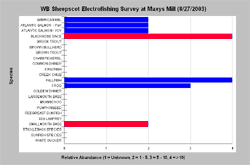 The West Branch Sheepscot was also electrofished by the Maine Atlantic Salmon Commission (ASC) near Maxys Mill (RKM 7.95) on August 27, 2003. While the occurrence of the nonnative blacknose dace may not pose much of a competitive or predatory risk to Atlantic salmon juveniles, the smallmouth bass would likely predate on salmon juveniles. There are no temperature records for this location.
The West Branch Sheepscot was also electrofished by the Maine Atlantic Salmon Commission (ASC) near Maxys Mill (RKM 7.95) on August 27, 2003. While the occurrence of the nonnative blacknose dace may not pose much of a competitive or predatory risk to Atlantic salmon juveniles, the smallmouth bass would likely predate on salmon juveniles. There are no temperature records for this location.
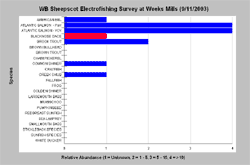 At right are the results of an electrofishing survey conducted by the Maine Atlantic Salmon Commission (ASC) in the West Branch Sheepscot River at Weeks Mills (RKM 20.77) on September 11, 2003. The survey showed a mostly native fish community with both brook trout and Atlantic salmon present. This river reach is substantially colder than those below it.
At right are the results of an electrofishing survey conducted by the Maine Atlantic Salmon Commission (ASC) in the West Branch Sheepscot River at Weeks Mills (RKM 20.77) on September 11, 2003. The survey showed a mostly native fish community with both brook trout and Atlantic salmon present. This river reach is substantially colder than those below it.
See Hypothesis #2 for map of temperature suitability for Atlantic salmon at this and other West Branch locations.
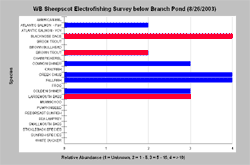 The West Branch Sheepscot River below Branch Pond (RKM 32.72) on August 26, 2003 had both brown trout and largemouth bass. Branch Pond is stocked with brown trout and largemouth were likely introduced there illegally. Pond populations are likely washed downstream by high flows, in the case of bass, or brown trout may prefer riverine habitats and relocate there volitionally. It is likely that both species prey on Atlantic salmon in this reach and brown trout juveniles may also compete for habitat and food resources. This location is closer to the headwaters and should be cooler and have more favorable conditions for salmon, but the pond location and stocking regime confound that possibility.
The West Branch Sheepscot River below Branch Pond (RKM 32.72) on August 26, 2003 had both brown trout and largemouth bass. Branch Pond is stocked with brown trout and largemouth were likely introduced there illegally. Pond populations are likely washed downstream by high flows, in the case of bass, or brown trout may prefer riverine habitats and relocate there volitionally. It is likely that both species prey on Atlantic salmon in this reach and brown trout juveniles may also compete for habitat and food resources. This location is closer to the headwaters and should be cooler and have more favorable conditions for salmon, but the pond location and stocking regime confound that possibility.
Mainstem Sheepscot River Fish Community Including Predatory Species
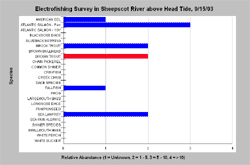 The fish community structure in the lower mainstem Sheepscot near Headtide (RKM 10.37) in September 2003 included Atlantic salmon, brook trout, American eel, fallfish and sea lamprey, but also the nonnative brown trout. Brown trout have the potential to predate on juvenile salmon and to compete with smolts and parr for food and space. Water temperatures at this location may be very warm (see Hypothesis #2), but there are no warm water fish, such as bass, possibly because of the proximity to salt water.
The fish community structure in the lower mainstem Sheepscot near Headtide (RKM 10.37) in September 2003 included Atlantic salmon, brook trout, American eel, fallfish and sea lamprey, but also the nonnative brown trout. Brown trout have the potential to predate on juvenile salmon and to compete with smolts and parr for food and space. Water temperatures at this location may be very warm (see Hypothesis #2), but there are no warm water fish, such as bass, possibly because of the proximity to salt water.
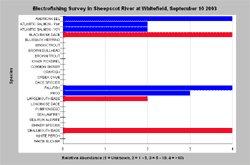 An electrofishing survey conducted by the Maine Atlantic Salmon Commission (ASC) in the Sheepscot River at Whitefield (river kilometer 17.25) on September 10, 2003 found Atlantic salmon juveniles, but also smallmouth and largemouth bass. This location represents high risk of predation for young salmon because they are at a competitive disadvantage due to very warm water temperatures at this location.
An electrofishing survey conducted by the Maine Atlantic Salmon Commission (ASC) in the Sheepscot River at Whitefield (river kilometer 17.25) on September 10, 2003 found Atlantic salmon juveniles, but also smallmouth and largemouth bass. This location represents high risk of predation for young salmon because they are at a competitive disadvantage due to very warm water temperatures at this location.
Relationship to Other Hypotheses (Potential Casual Mechanisms)
Hypothesis #1: Atlantic salmon often school and use collective evasive tactics to avoid predation. Such adaptations may be less effective when salmon populations reach low levels and there are insufficient numbers of juveniles to participate in schooling behavior.
Hypothesis #2: Man-made or enlarged lakes and ponds provide habitat for nonnative species and water temperatures are increased by impoundments during summer. This reduces the extent of cold water reaches and shifts some habitat toward less favorable or unusable for Atlantic salmon. Although these impoundments have high recreational value and local use, they cumulatively effect the Sheepscot River ecosystem in a way that limits Atlantic salmon recovery prospects.
Hypothesis #3: If Sheepscot River channels have been simplified and filled in, then width to depth ratios would contribute to warming, which favors introduced warm water species. Habitat simplification reduces the ability of co-evolved species such as Atlantic salmon and brook trout to partition niches, so competition with native species could increase. Cover elements such as large wood and the matrix between clean cobble and gravel on the stream bottom would have provided places where salmon juveniles could have avoided predation. Many reaches of the Sheepscot River are recognized as lacking habitat diversity and cover, where predation from both native and nonnative fish and avian predators salmon parr and smolts could be expected. Dead water areas where pickerel predation is noted may be very different than historic habitats.
Hypothesis #4: Reservoirs above dams in the Sheepscot River are where nonnative fish species thrive. Warmwater species such as largemouth and smallmouth bass wash downstream from these impoundments. Dams also block salmon passage, preventing them from re-colonizing headwater areas where they might be subject to less competition and predation.
Alternative Hypothesis #1 Predation on and competition from nonnative fish species are not significant impacts on Sheepscot River Atlantic salmon populations.
There are some discussions in existing literature that support alternative hypothetical relationships between Atlantic salmon and some nonnative species. For example, the MASC (1997) stated the following with regard to brown trout, landlocked Atlantic salmon and some introduced warm water fish species:
- "Although competition could potentially limit smolt production from this section of Sheepscot River, they believe brown trout presently occupy up to six percent of the salmon habitat in the drainage. While brown trout could prey on Atlantic salmon juveniles in the Sheepscot River, most brown trout reside in the headwater section below Sheepscot Lake where few Atlantic salmon spawn.. Therefore, biologists do not believe predation and competition from brown trout represent a problem even in this watershed......
- Observations and angler surveys by ASC and DIF&W biologists suggest that this (landlocked AS vs Anad AS) competition and predation issue is minor.....
- Habitat partitioning between warmwater fish species (bass, chain pickerel, yellow perch) and parr probably limits predation in rearing habitat."
Although Meister (1982) did express some concern, as noted above, about interactions of introduced bass species with Atlantic salmon, he also stated that: "While it seemed likely that the bass introduction would effect some change in the coldwater fish populations in Sheepscot Pond, there is little evidence the expected changes were all detrimental."
Monitoring Trends to Test the Hypotheses
Methods for gathering information to test these hypotheses could include:
1) Monitoring competition between brown trout and Atlantic salmon, including standing crops or biomass. Target areas would be West Brach below Branch Pond and mainstem below Sheepscot Pond.
2) Removal of one or more dams and subsequent limnological and biological monitoring to see if community structure shifts more towards the cold adapted native community.
References
Arter, B. S. 2004. Sheepscot River Water Quality Monitoring Strategic Plan: A guide for coordinated water quality monitoring efforts in an Atlantic salmon watershed in Maine. Prepared for the Project SHARE: Research and Management Committee. 84 pp. [975kb]
Barr, L.M. 1962. The life history of chain pickerel, Esox niger Leseuur, in Beddington Lakes, Maine. M.S. Thesis. University of Maine, Orono. ME. 88 pp.
Boucher, David. 2005. Illegal Fish Stickings Threaten Maine Lakes and Rivers. Maine Department of Inland Fisheries and Wildlife on-line information at http://www.state.me.us/ifw/fishing/illegalstocking.htm
Bryant, F. G. and J.V. Mahoney. 1950. West Branch of the Sheepscot River stream survey. Memo file cards containing information. U.S. Fish and Wildlife Service, Atlantic Salmon Investigations for the Maine Atlantic Sea Run Salmon Commission. Bangor, ME. 53 pp. 3.5Mb**
Danie, D.S., J. G. Trial, and J. G. Stanley. 1984. Species profiles: life histories and environmental requirements of coastal fish and invertebrates (North Atlantic) -- Atlantic salmon. U.S. Fish Wildlife Service.. FWVOBS-82/11.22. U.S. Army Corps of Engineers, TR EL-82-4. 19 pp. [500kb]
Foye, R.E. 1967. Maine Rivers: the historical Sheepscot. Maine Department of Inland Fisheries and Game. 9(2): 8-11.
Kennebec Soil and Water Conservation District (KSWCD). 2003. Water quality restoration of the West Branch Sheepscot: Final report. Written for KSWCD by M. Halsted. Funded by Maine Department of Environmental Protection §319H Project #99R-30. 31 pp. [2.8Mb]
Maine Atlantic Salmon Task Force (MASTF). 1997. Atlantic Salmon Conservation Plan for Seven Maine Rivers. Task Force appointed by the Governor of Maine. 353 p. [1.6Mb]
McCullough, D. 1999 . A Review and Synthesis of Effects of Alterations to the Water Temperature Regime on Freshwater Life Stages of Salmonids, with Special Reference to Chinook Salmon. Columbia Intertribal Fisheries Commission, Portland, OR. Prepared for the U.S. Environmental Protection Agency Region 10. Published as EPA 910-R-99-010. [900 kb]
Meister, A. L. 1982. Sheepscot: An Atlantic salmon river management report. Atlantic Sea Run Salmon Commission. Bangor, ME. 47 pp. [3.7Mb]**
Metcalfe, N.B. and J.E. Thorpe. 1992. Early predictors of life-history events: the link between first feeding date, dominance and seaward migration in Atlantic salmon, Salmo salar L. J. Fish Biol. 41(Suppl. B):93-99.
National Research Council. 2003. Atlantic Salmon in Maine. Committee on Atlantic Salmon of Maine, National Research Council, National Academy of Sciences, National Academy Press, Washington D.C. [3.5Mb]
Van den Ende, O. 1993. Predation on Atlantic salmon smolts (Salmo salar) by smallmouth bass (Micropterus dolomieu) and chain pickerel (Esox niger) in the Penobscot River, Maine. M.S. Thesis, University of Maine, Orono, Maine. 95pp.